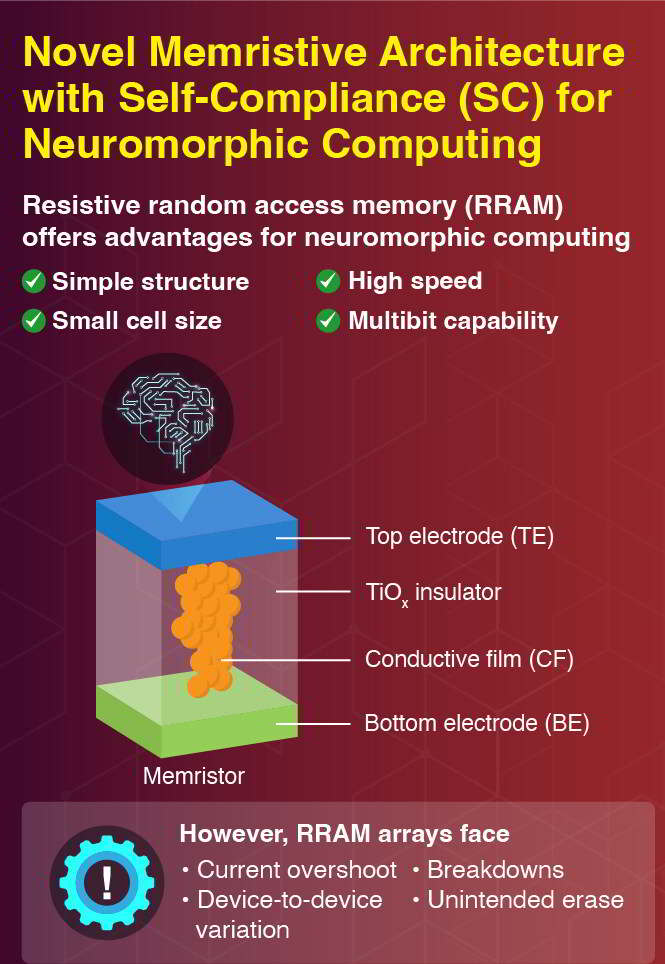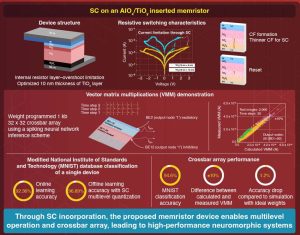Self-Compliant Memristive Devices, Breakthrough in Neuromorphic Computing from Dongguk University
Researchers built neural network using 32x32 crossbar array of their memristors to demo spiking neural network-based VMM operations.
This is a Press Release edited by StorageNewsletter.com on October 31, 2024 at 2:00 pmIn recent years, AI and IoT have progressed rapidly, driving advancements in areas like speech recognition, image classification in autonomous vehicles, and large language models like ChatGPT. A key element in AI is deep learning (DL), which requires parallel processing of large amounts of data – an area where traditional computers still struggle with efficiency. Neuromorphic or brain-like computing systems, consisting of artificial neurons and synapses, offer low power consumption and efficient data processing.
Novel memristor device achieves self-compliance, which enables crossbar array
and multilevel operation as synaptic arrays for high-performance neuromorphic computing systems
One of the most promising semiconductor technologies for neuromorphic computing is the RRAM, a type of memristive device. Memristive devices have the unique ability to ‘remember’ past electrical states. In RRAM, this memory effect arises from the formation and dissolution of a conductive filament (CF) in the insulator layer of its metal-insulator-metal structure. Metal oxide insulators play an essential role in this process. However, while titanium-oxide-based RRAMs offer several advantages, they suffer from device-to-device variations, caused by overshoot currents during CF formation. This can lead to breakdowns or unintended memory erasure. Current methods to mitigate overshoot currents require the addition of transistors or external current compliance (CC) settings, increasing complexity.
In a breakthrough now, a research team from South Korea, led by Professor Sungjun Kim, Division of Electronics and Electrical Engineering, Dongguk University, developed a self-compliance (SC) memristor device that overcomes these issues.
Elaborating further, professor Kim says: “In this study, we achieved SC on a high-density two-terminal memristor and implemented vector-matrix multiplication (VMM), the core of AI semiconductor computation, on a 32×32 memristor array.”
Study was made available online on August 21, 2024, and published in Volume 18, Issue 36 of ACS Nano on September 10, 2024. (see below)
Click to enlarge
The innovative memristor device has an aluminum oxide/titanium-oxide (AlOx/TiOy) layer on top of the insulator layer. This layer acts as an internal resistor, preventing overshoot currents by controlling the thickness of the CF formed during switching, which achieves SC. The researchers fine-tuned the TiOy layer to 10 nanometers, improving the device’s performance.
Through a series of experiments, the researchers demonstrated the device’s consistent switching characteristics without external CC and reliable multilevel operation with low power consumption. They also studied the device’s long-term potentiation (LTP) and long-term depression (LTD) characteristics, which represent the strength of synaptic connections between neurons in neuromorphic computing systems.
Using these characteristics, they simulated neural networks based on the device to classify images from the well-known MNIST database. Results revealed an online learning accuracy of 92.36%. Furthermore, offline learning neural networks that leveraged the device’s SC multilevel mode achieved an accuracy of 96.89%.
Ultimately, the researchers built a neural network using a 32×32 crossbar array of their memristors to demonstrate spiking neural network (SNN)-based VMM operations. SNNs, which mimic the computation processes of the brain, are known for their low power consumption. The crossbar array-based neural network achieved a 94.6% classification accuracy on the MNIST dataset, with only a 1.2% accuracy drop compared to simulation results, which shows its capabilities.
“Memristor arrays will be pivotal in next-generation computing architectures due to their speed, efficiency, and scalability,” remarks Kim. “Beyond neuromorphic computing, they have a wide range of potential applications, including non-volatile memory, IoT, machine learning, and cryptography. Furthermore, neural processing units, specialized for AI operations, require memory chips tailored for VMM operations such as the high yield memristor array developed in this study,” he adds.
Paper: Memristive Architectures Exploiting Self-Compliance Multilevel Implementation on 1kb Crossbar Arrays for Online and Offline Learning Neuromorphic Applications
ACS Nano has published an article written by Sungjoon Kim, Department of AI Semiconductor Engineering, Korea University, Sejong 30019, Republic of Korea, Hyeonseung Ji, Division of Electronics and Electrical Engineering, Dongguk University, Seoul 04620, Republic of Korea, Kyungchul Park, Department of Electrical and Computer Engineering and Inter-University Semiconductor Research Center (ISRC), Seoul National University, Seoul 08826, Republic of Korea, Hyojin So, Division of Electronics and Electrical Engineering, Dongguk University, Seoul 04620, Republic of Korea, Hyungjin Kim, Division of Materials Science and Engineering, Hanyang University, Seoul 04763, Republic of Korea, Sungjun Kim, Division of Electronics and Electrical Engineering, Dongguk University, Seoul 04620, Republic of Korea, and Woo Young Choi, Department of Electrical and Computer Engineering and Inter-University Semiconductor Research Center (ISRC), Seoul National University, Seoul 08826, Republic of Korea.
Abstract: “This paper suggests the practical implications of utilizing a high-density crossbar array with self-compliance (SC) at the conductive filament (CF) formation stage. By limiting the excessive growth of CF, SC functions enable the operation of a crossbar array without access transistors. An AlOx/TiOy, internal overshoot limitation structure, allows the SC to have resistive random-access memory. In addition, an overshoot-limited memristor crossbar array makes it possible to implement vector-matrix multiplication (VMM) capability in neuromorphic systems. Furthermore, AlOx/TiOy structure optimization was conducted to reduce overshoot and operation current, verifying uniform bipolar resistive switching behavior and analog switching properties. Additionally, extensive electric pulse stimuli are confirmed, evaluating long-term potentiation (LTP), long-term depression (LTD), and other forms of synaptic plasticity. We found that LTP and LTD characteristics for training an online learning neural network enable MNIST classification accuracies of 92.36%. The SC mode quantized multilevel in offline learning neural networks achieved 95.87%. Finally, the 32 × 32 crossbar array demonstrated spiking neural network-based VMM operations to classify the MNIST image. Consequently, weight programming errors make only a 1.2% point of accuracy drop to software-based neural networks.“















 Subscribe to our free daily newsletter
Subscribe to our free daily newsletter

